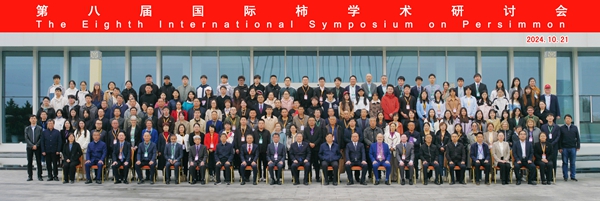
 Home»
News
Home»
News
On October 21st, the 8th International Symposium on Persimmon officially opened in Yangling, Shaanxi Province.
Under the guide of International Society for Horticultural Science (ISHS) and Chinese Society for Horticultural Science (CSHS), this symposium was jointly organized by Northwest A&F University (NWAFU), State Key Laboratory for Crop Stress Resistance and High-Efficiency Production (NWAFU), Huazhong Agricultural University (HZAU), National Key Laboratory for Germplasm Innovation & Utilization of Horticultural Crops (HZAU), Department of Agriculture and Rural Affairs of Shaanxi Province, Management Committee of Yangling Agricultural High-tech Industry Demonstration Zone and Fuping Persimmon Industry Association, and supported by College of Horticulture of NWAFU, Administration for Rural Revitalization of Management Committee of Yangling Agricultural High-tech Industry Demonstration Zone and Yangling Fruit Industry Innovation Center.

During the opening ceremony, speeches were delivered by Luo Jun, Vice President of NWAFU; Ren Buxue, Deputy Director-General of the Shaanxi Provincial Department of Agriculture and Rural Affairs; Ma Jiangtao, Deputy Director of the Yangling Agricultural High-tech Industry Demonstration Zone Management Committee; and Ryutaro Tao, Director of the Graduate School of Agriculture at Kyoto University.
On behalf of NWAFU, Luo Jun expressed warm congratulations on the opening of the 8th International Symposium on Persimmon and extended a sincere welcome to all the guests. He introduced the university’s fine tradition of supporting rural revitalization, fostering scientific and technological advancements, and facilitating the transformation of achievements, while also highlighting its notable contributions to the high-quality development of agriculture. Furthermore, he hoped that experts of this symposium would generate new academic insights during this event.
Ren Buxue emphasized the necessity of persistently promoting the indigenous Chinese persimmons, highlighting the significance of advancing China’s agricultural high-quality development in terms of cultivating superior seed varieties, exploring value products added, deepening industrial integration, leveraging digital technology, and strengthening cooperation and exchanges.
Ma Jiangtao expressed his insight to enhance communication and cooperation in various aspects related to the persimmon industry, including seed selection and preservation, cultivation demonstration, brand development, market promotion, exploration and utilization of diverse values, so as to empower the growth of regional specialty industries, aiming for renewal, acceleration, and improvement.
Ryutaro Tao hoped that through this symposium, closer cooperative relationships could be established, laying a solid foundation for further development in the persimmon industry and other horticultural industries.
The symposium lasted for 5 days, bringing together over 100 experts and scholars from across China and renowned figures in the international horticultural community to discuss the latest research findings and development trends in persimmons. The symposium featured 3 keynote forums and 41 academic presentations, covering various aspects including the current state of the persimmon industry, persimmon genomics, genetics, breeding, and crop management. Japanese persimmon breeding experts Keizo Yonemori and Ryutaro Tao, Prof. Edgardo Giordani from Italy, Prof. Gwangwan Ahn from South Korea, and Tahir Khurshid from Australia comprehensively demonstrated the latest progress of the persimmon industry in terms of scientific research, technological innovation, and industrial development in their presentations.
During the symposium, participants visited China National Persimmon Field Genebank and China Persimmon Museum to deepen their understanding of persimmon industry research.
From its origin, widespread cultivation, to the selection and large-scale promotion of new varieties, persimmon has always been an integral part of Chinese farming culture.
China National Field Genebank for Persimmon, one of the first 15 National Fruit Tree Germplasm Resource Repository by the Ministry of Agriculture, is located in Yangling thanks the outstanding advantages of the research team led by Yang Yong from Horticulture College of NWAFU in the field of persimmon industry research. It not only preserves the largest number of persimmon germplasm resources with the richest genetic traits worldwide, but also provides a valuable gene bank and experimental field for the research and development of persimmon industry.
China is the origin of persimmons, as recorded by Erya (《尔雅》) that the cultivation of persimmons in China began over 3,000 years ago, and also by the descriptions in Nei Ze (The Inner Chapters) of The Book of Rites (《礼记内则》) more than 2,000 years ago.

Translated by: Li Xinran
Proofread by: Zhang Xiaorong